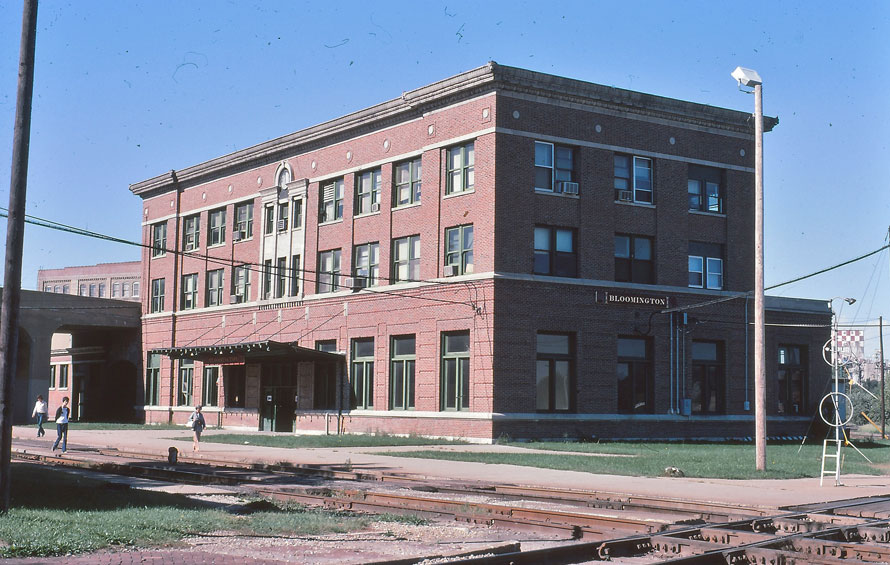
“We have been dreaming of this thing for the past ten, twenty, thirty years—or how long is it anyway since Bloomington’s people began to feel ashamed of their present station. There have been numerous agitations in years past to coax, threaten, cajole, bulldoze or frighten the former managements into giving Bloomington a presentable station in place of the lamentable affair pictured herewith, but all without success until the present negotiations were crowned with success.”
The Daily Bulletin, June 2, 1910
For much of the 19th and 20th Centuries, Bloomington, Illinois was a textbook railroad town. Several rail lines crossed each other in different directions all throughout the city. The busiest of these junctions was on the west side of town off of Washington Street at a place later known as “BN (Bloomington-Normal) Target,” where the north-south Chicago & Alton (later Gulf, Mobile & Ohio and now Union Pacific) crossed the east-west Lake Erie & Western (later Nickel Plate Road and now Norfolk Southern) and Peoria & Eastern (later Conrail and now abandoned) railroads.
The Chicago & Alton was the first railroad to arrive at this location. Eventually running from Chicago to St. Louis and points west, the C&A had laid track through Bloomington by late 1853 and trains were running regularly the following year. Several blocks to the north of BN Target were the C&A’s main shop facilities. Known locally as the “C&A Shops” or just “The Shops,” these facilities were, for many years, the largest employer in the city.
The next railroad built through the BN Target area was the Indianapolis, Bloomington & Western Railway, which would later become the Peoria & Eastern Railway. The IB&W reached Bloomington in the late 1860s and trains began running in 1869. A couple of years later, the Lafayette, Muncie & Bloomington Railroad built their own line through Bloomington, which ran directly next to the IB&W through town. The LM&B became the Lake Erie & Western Railway by 1879. Both of these railroads ran east to west, eventually reaching Peoria, Illinois.
Shortly after the two east-west railroads were completed, work began on the construction of a union depot at BN Target. It opened in 1873 and replaced the original Bloomington depot that had been located off of Chestnut Street near the C&A Shops. It was a small wood frame structure, typical of 19th Century station buildings. Waiting rooms, a freight and baggage room, and an office for the agent made up the interior. Outside, decorative trim gave the building a welcoming appearance to travelers, citizens, and railroad workers alike.
In early July of 1894, Bloomington Union Depot became the gathering spot for thousands of Bloomington residents who came out to witness the “Great Alton Tie-Up,” where over a dozen trains were parked around the depot area after their crews abandoned them in protest of unfair working conditions for employees of the Pullman Company shops near Chicago. This strike ended within a week but remains perhaps the most interesting event that happened at the station.
By 1905, the 1873 station was beginning to show its age. Bloomington residents frequently complained about its inadequate size for the increasing number of people who utilized it. Planning soon began for a newer and much larger union depot. After many months of the three railroads and the town bickering back and forth for a location, it was decided that the new building was to be constructed at the exact same location as the 1873 structure, in the southwest quadrant of the junction. The C&A began taking bids for a scrapper who would take down the old structure. It was carefully dismantled in January of 1913, with many pieces being saved for reuse on the new structure.
Architects Henry Raeder and W. E. Wood were hired by the C&A to design the new station. The first plan was to build a massive four-story structure with an 80-foot clock tower. However, for various reasons, the railroads ordered Raeder and Wood to come up with a simpler design.
Eventually, all parties agreed upon a not as elaborate but still classy three-story brick building with decorative stone trim and an attached overpass immediately south of the depot to allow a safer way for passengers to cross the tracks. Construction was underway by February of 1913. Chicago & Alton carpenter J. W. Gibson was put in charge of overseeing the construction process. A temporary spur track was built near the site so carloads of building material could be dropped off at an easily accessible location.
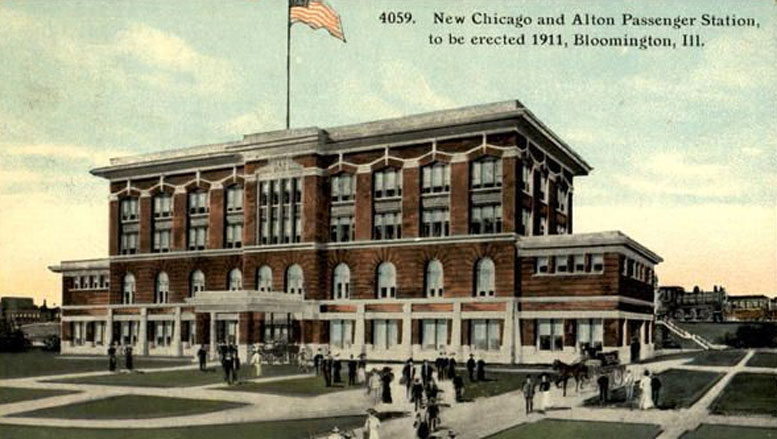
Work was finally completed in late September of 1913. The railroads began moving dispatchers and other office employees into the upper two floors of the depot while the main floor was the actual station facility. The bridge immediately south of the depot carried Front Street and a sidewalk for pedestrians over the C&A tracks. Once parallel with the station, the street took a sharp turn and descended back down to ground level. In later years, parking spaces were added to the sloping part of the street. The station’s baggage and Railway Express Agency offices were located under this area. At each corner of the building where the walls met the roof, a fancy sculpture of a lion overlooked the grounds below.
Completed at a cost of $84,000, the new Bloomington Union Depot opened on October 2, 1913, with much fanfare. About 1,500 people attended the opening ceremony. The first train was a southbound on the Chicago & Alton. Alonzo Dolan, a local railroad enthusiast (railfanning was not yet a thing) and reporter for The Pantagraph, a Bloomington newspaper, bought the first ticket. It was a round trip to Shirley, the next stop to the south. Trains on the Lake Erie & Western and Peoria & Eastern also began stopping there on that day. These two railroads also shared another station closer to downtown Bloomington but interestingly stopped at both.
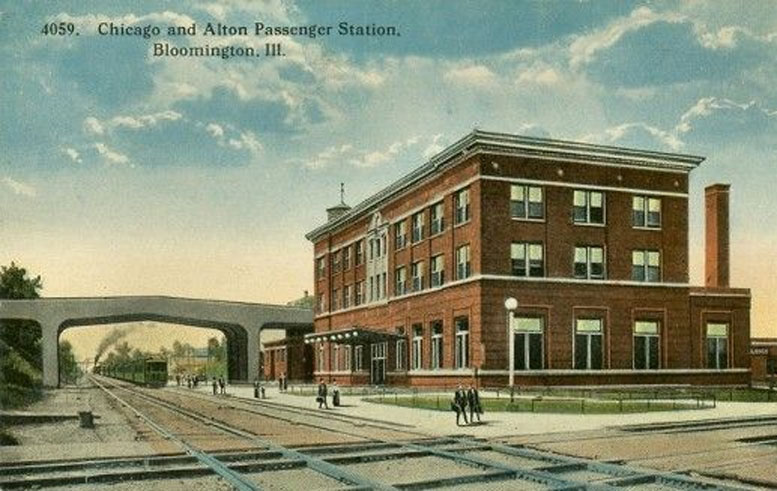
Soon, Bloomington Union Depot became the most integral place in the city. With dozens of trains stopping there daily, the depot and accompanying platforms became a gathering spot. One could catch a train there to several major cities–Chicago, Peoria, St. Louis, Kansas City, Indianapolis, and other points east and west. At one point, a small coffee shop or restaurant opened inside of the depot’s first floor. Newspapers could be purchased there, and mail could be shipped or received. Throughout its history, many notable people (mostly presidential candidates) made stops at both the old and new stations to give speeches. These people included Theodore Roosevelt, Franklin Roosevelt, Gerald Ford, and several others.
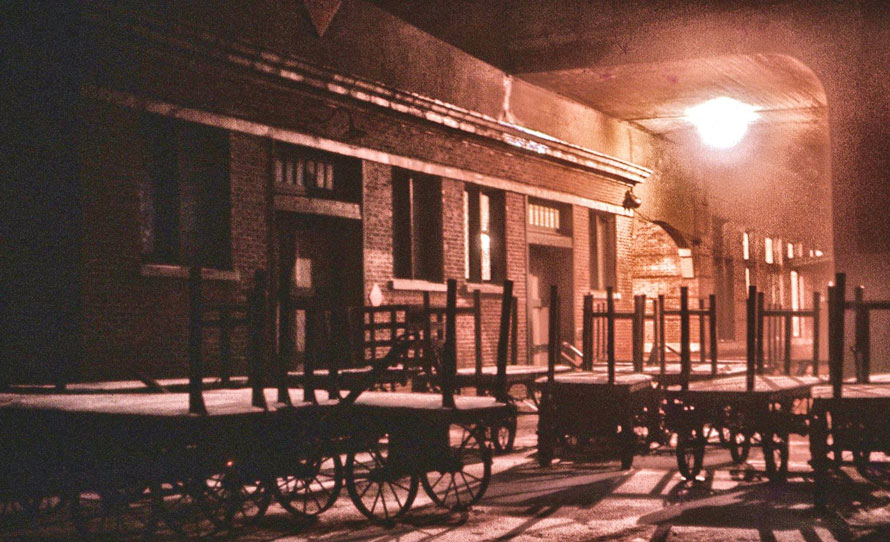
“Yes, indeed, the Union Depot is a gigantic stage, upon which there are many players; each one entering–some once, some often–but each one playing a minor or a major role, then taking his bow, and making his exit, to make room for the countless thousands that shall follow through the future generations.” –William B. Clooney, Station Agent
Located directly across the Lake Erie & Western and Peoria & Eastern tracks was the BN Target Box, where operators controlled train movements across the junction. Bill Dunbar, known locally as a “walking Chicago & Alton encyclopedia,” was one of the operators there for many years. Many railfans recall being with him inside of the Target Box learning how to operate the junction and watching trains trundle through the city for hours at a time.
World War I brought increased activity to Bloomington Union Depot. Men leaving to serve in Europe gave tearful farewells to their loved ones as their train pulled out of the station, not knowing if they would ever return. After the war had ended, many of these same men returned with emotional reunions, while others came in flag-draped coffins, having given the ultimate sacrifice for their country. These events were repeated hundreds, if not thousands of times at the depot during World War II, Korea, and Vietnam as well. During these wartime periods, the local Red Cross chapter set up canteens at the depot, where traveling soldiers were served sandwiches, drinks, cigarettes, and chewing gum.
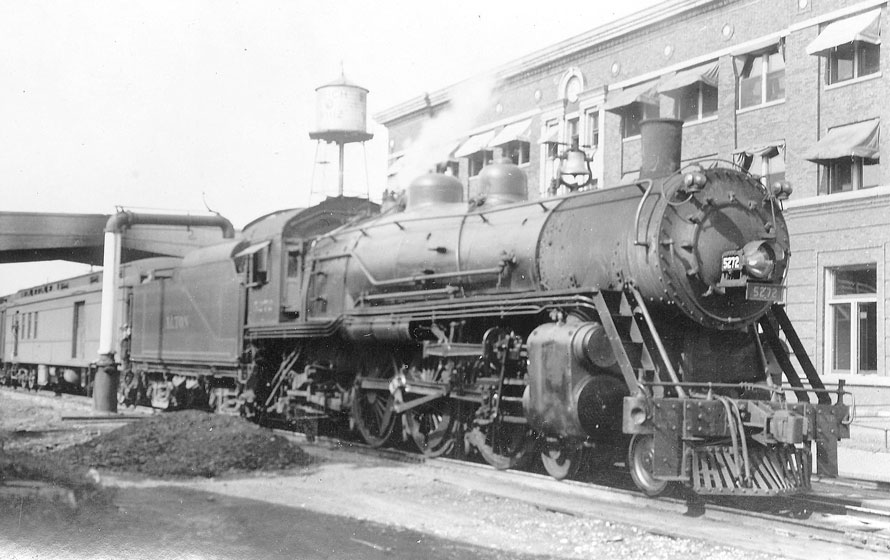
Less than 10 years after it opened in 1913, what would eventually become a series of mergers and sales of the railroads that served Bloomington Union Depot began. In 1922, the Lake Erie & Western was acquired by the New York, Chicago & St. Louis Railroad (Nickel Plate Road). The NKP continued to use Union Depot for passenger trains, though service and train frequency began to decline during World War II.
In 1931, the Chicago & Alton became a subsidiary of the Baltimore & Ohio. In 1947, it was sold outright to the Gulf, Mobile & Ohio. The GM&O continued to use the depot to the fullest extent until it too began to decrease passenger service as a result of increasing competition with automobiles and air travel. For many years, famed GM&O trains such as the Abraham Lincoln, Alton Limited, and Midnight Special made stops at Bloomington.
The beginning of the end for Bloomington Union Depot came on December 1, 1950, when the Nickel Plate discontinued passenger train operations through Bloomington altogether. The last train was westbound No. 21 to Peoria. The short three car train left the platform for the last time at 3:46 PM. The equipment deadheaded back east the following day but did not stop at Union Depot.
On October 14, 1957, the Peoria & Eastern’s last two passenger trains, the east and westbound Corn Belt Special, made their last run. Previous protesting from Bloomington citizens to keep the trains running failed, and many purchased tickets on the last day to ride the last run. A single GP7 diesel led the westbound run into Bloomington at around 12:30 PM. An extra car was added to accommodate the unusually large number of riders. The eastbound returned to Bloomington at 3:25 PM. From that point on, there was no more east-west passenger service at Union Depot.
Despite the ongoing competition and subsequent financial challenges with running passenger trains, the GM&O’s passenger service managed to hang on. In addition to Chicago to St. Louis service, Bloomington Union Depot was also the originating and terminating point for the GM&O’s Doodlebug, which ran from Bloomington to Kansas City over a branch line that began at BN Target. This service was discontinued in 1960, but trains on the mainline continued to operate. The May 1, 1971 formation of Amtrak eliminated GM&O passenger trains, but Amtrak continued to utilize the Chicago to St. Louis route and Bloomington Union Depot.
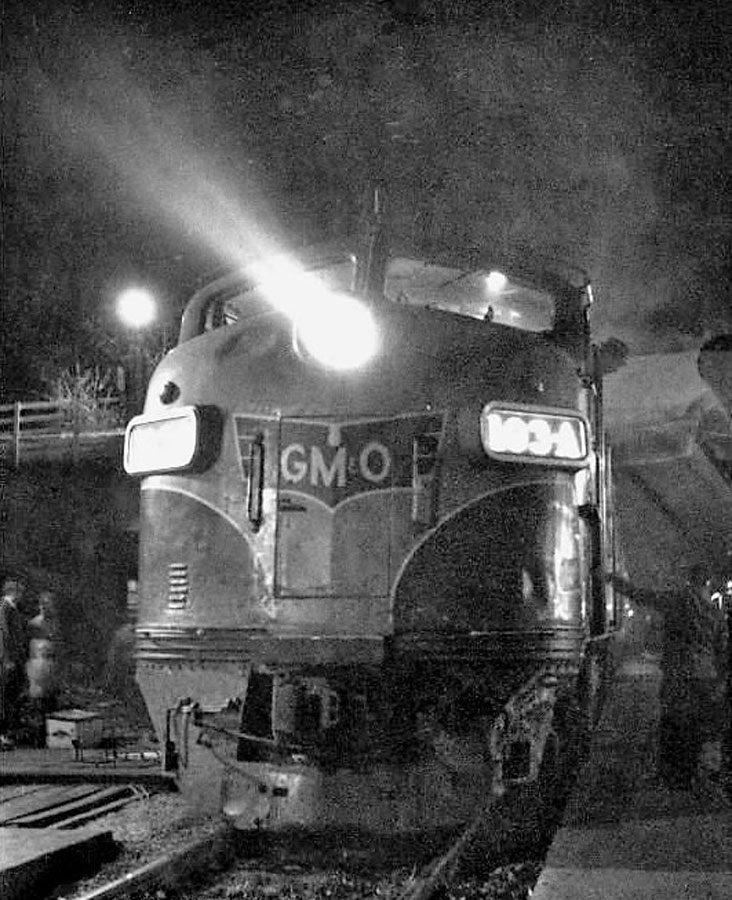
The August 10, 1972 merger of the GM&O and Illinois Central to form Illinois Central Gulf was arguably the fatal blow to Union Depot. Within a few years of the merger, the office positions located in the upper floors of the depot were either relocated to Chicago or abolished. The rooms were emptied, the doors were locked, and soon, without any maintenance being done, the roof began leaking and deteriorating the second and third floors.
Several Vietnam veterans who boarded their bootcamp-bound trains at Union Depot recalled that the station had a rather creepy atmosphere, not just because of the fear of going to war, but also because of the building’s run-down appearance. Broken and boarded up windows and the deteriorating Front Street overpass gave an unwelcoming feeling to visitors. By the late 1970s, the upper floors of the depot were in very bad shape. Water was leaking almost constantly into the passenger waiting room and ticket office area on the first floor. A remodeling project temporarily solved the problem and gave the interior a more modern and welcoming appearance, but the depot continued to fall apart.
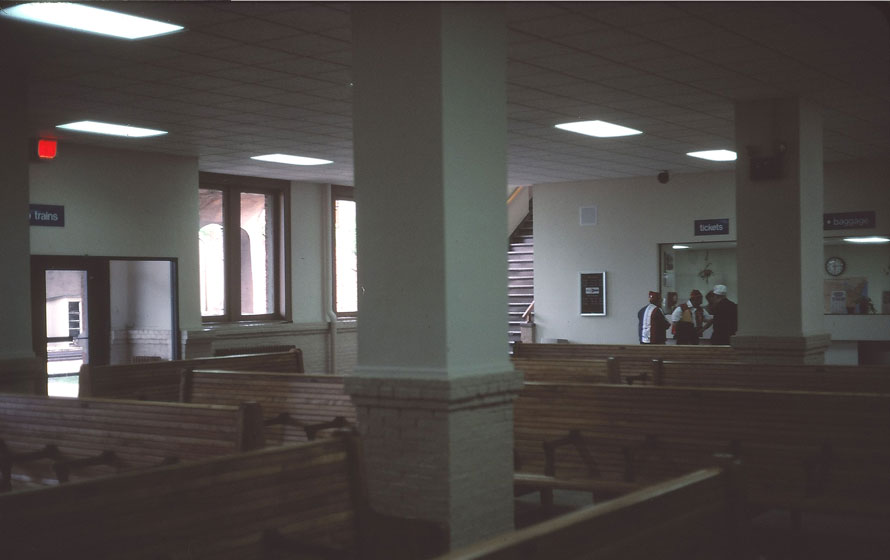
In addition to the deterioration, the station had become understaffed and those who worked there found it quite difficult to manage the large structure. Oftentimes, there was only one person working there at a time. The neighborhood around the depot was becoming more run down and dangerous. Vandals and vagrants often came to the depot at night and messed with things, and the agents had a hard time managing that while tending to the passengers. The agents also had to serve as janitors. “The old station had become a self-perpetuating problem,” said station agent Steve Gossard in his book, A History of the Chicago & Alton Railroad Stations in Bloomington-Normal, Illinois.
After some discussion, the community decided that it would be best to construct a new station a couple of miles north in Normal, which was (and still is) home to Illinois State University. ISU students and visitors made up the majority of Amtrak passengers that used the station and having a new facility closer to campus was expected to increase the number of passengers.
June 10, 1990 was the last day of operations for Bloomington Union Depot. The new station in Normal was ready for service, so Amtrak began relocating station materials there. Southbound train 309, the State House, was the last train to stop at Union Depot. It was greeted there by a crowd of people wanting to see the last train. After its 9:11 PM departure, the station agents opened the depot for everyone to take one last look around before it closed. The following day, additional materials were removed and relocated to the Normal station, including some wooden benches that dated to Union Depot’s 1913 construction. The benches remain in the Normal station to this day.
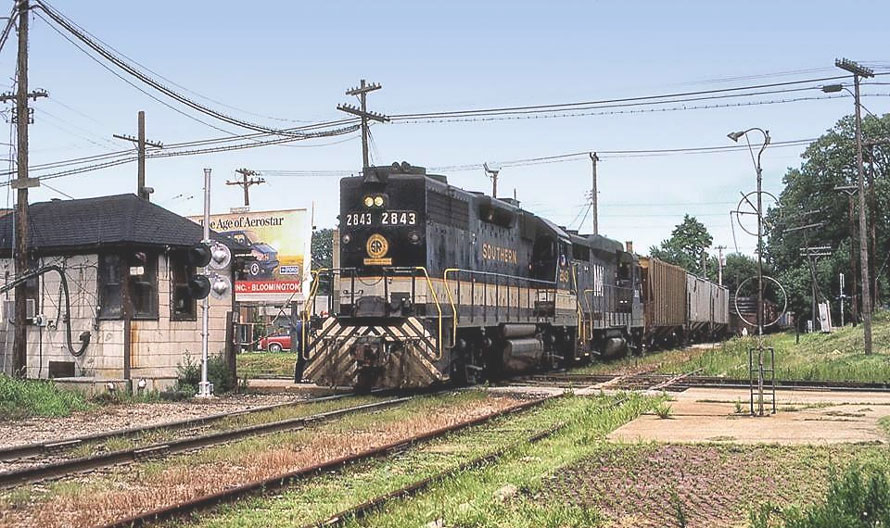
After that, Bloomington Union Depot was boarded up and left to rot. The BN Target Box remained open for a little while longer, but it was closed and demolished around 1995. The place was a shell of its former self. The Peoria & Eastern tracks had been removed a few years prior, after successor Conrail decided to abandon the line from Bloomington westward. The former Chicago & Alton line had been sold to the Chicago, Missouri & Western in the late 1980s. The CM&W went bankrupt early on, and the track condition rapidly deteriorated. The line was sold again to the Southern Pacific in 1989. The Nickel Plate, now owned by Norfolk Southern, was in the best condition at the time of the depot’s closure but did not see many trains.
About 1996, the Southern Pacific became concerned about the deteriorating Front Street overpass. Chunks of concrete from the bridge had fallen onto the tracks, and upon inspection, it was determined that the bridge was in very poor condition and unsafe for motorists and pedestrians. The road and sidewalk were quickly closed and discussions began on what to do with it.
The city and railroad decided the best option was to demolish the bridge. Demolition engineers inspected it and returned to the city with some saddening news: if the bridge had to go, Union Depot had to go too, as the bridge was attached to the station building. Demolition of just the bridge would likely compromise the station’s structural integrity. The City of Bloomington and Southern Pacific had been trying unsuccessfully to find a new owner for the depot since its closure, with a hope that it would be restored and repurposed.
Demolition of Bloomington Union Depot began in October of 1997. First, workers emptied the interior of all furniture and appliances and then began taking down the building from the south end and working their way north.
During this process, on Halloween night, vandals broke into the depot and started a fire. The blaze gutted the interior, but despite some doors and windows that had been destroyed to assist firefighting efforts, the exterior still stood proudly with minimal damage, a true testimony to the skilled craftsmen who had built the depot eighty-four years earlier. After the fire investigation was complete, demolition progressed quickly. The last wall unceremoniously came tumbling down in early 1998 in a shower of bricks and dust.
Today, there is nothing left of Bloomington Union Depot. The lot that it once occupied now has a bike path running through it. There are no plaques or historical markers indicating what was once there. Over the years, railfans and history buffs picked the site clean of remaining bricks and chunks of foundation that were left behind by the demolition crews. Amtrak, Union Pacific (successor to the Southern Pacific) and Norfolk Southern trains still bang across the diamonds there, but never stop. In all likelihood, the people aboard those trains have no idea what was once there. A rather sad ending for a magnificent railroad station.
However, the memory of Union Depot still lives on. Photographs and video footage of the station are plentiful, and many longtime Bloomington residents have fond memories of going there. The McLean County Museum of History, located in the historic Bloomington courthouse, has a large amount of material on the station available for the public to view, including the writings of William B. Clooney, who served as one of the Bloomington station agents from the time the depot opened in 1913 to his retirement in 1968. In one of those writings, Clooney wrote:
“There shall always be a Union Depot, just so long as there shall be a railroad, which shall be so long as our citizens appreciate and protect their liberty, for it has been demonstrated in the two world conflicts that the railroads are indispensable to the life and development of this nation.”
Thomas Dyrek – Photographs and text Copyright 2021
Thanks for the fine and interesting article. In 1979, I managed a study of the Chicago to St. Louis Corridor for IDOT. Target was still in service just north of the Bloomington Normal Station and was a non-interlocked crossing. Every train had to come to a full stop before being allowed to proceed. The ICG had a dispatching office in the Bloomington Normal Station with a CTC machine that controlled from south of Joliet to south of Alton. Steve McEvoy
In Feb., 1990, I was a newly promoted rules instructor on Southern Pacific, having been an unpromoted rules instructor since early October, 1987, covering the SP system. I had been a train dispatcher and chief dispatcher of the San Antonio Division for many years prior to undertaking the rules instructor tasks.
With my formal promotion, I was assigned to Roseville, California, as Western Region rules instructor but before heading for Roseville, the first week of March, 1990,I was sent to the newly-acquired SPCSL territory to teach SP rules to the former GM&O-IC-CM&W train dispatchers at Springfield and interlocking oprs at Ridgeley and other open manual interlocking plants on the property.
In the course of these endeavors, I was able to ride many Amtrak trains between Chicago and St. Louis over a three-week period to familiarize myself with the railroad as to where the nooks and crannies were. That was to prove beneficial in very early 1995 when I became asst mgr of operating rules for the SP System, charged with producing employee timetables, general orders, and other operating documents for the entire SP system.
In my travels, I became very aware of the station building at Bloomington and was impressed by its architecture, giving thought to the history it must possess, as well as the quantity of operating records it might well house. I was able to spend time walking around the depot in the course of my train rides, being headquartered in Springfield, but was never able to enter the building proper because it was well secured. The train dispatchers in Springfield that I had taught rules classes to told me very little about the building, saying basically that there was nothing of interest in it and that it was fundamentally empty.
I made a ten-day return trip to the SPCSL in March or April, 1991, or 1992 (I can no longer remember which) to do a traffic study at Wann Tower as SP wanted to close that facility and transfer control of that interlocking to a train dispatcher in the SP/DRGW office in Denver. I found sufficient reasons to keep Wann open for another two years until the power-to-be finally overruled me and closed it.
The SPCSL showed considerable evidence of its B&O heritage with color-position light signals, lengthy sidings carved from former double track territory, and some remarkable depot and station structures that were evidence of a 1920’s-architecture that reflected a small-town urban America.